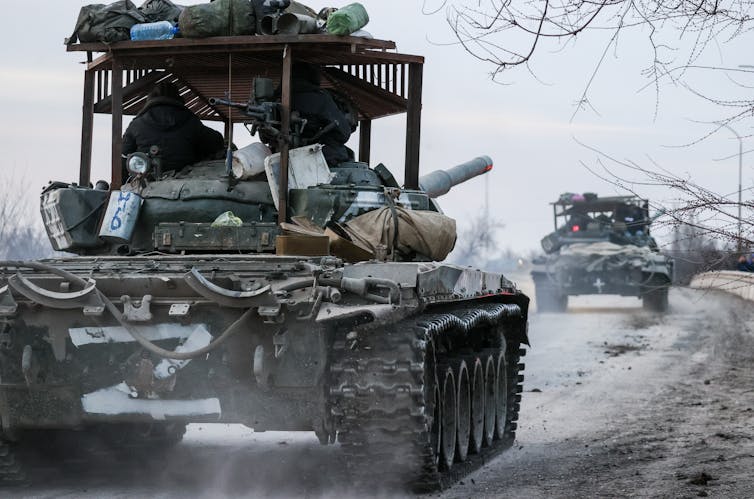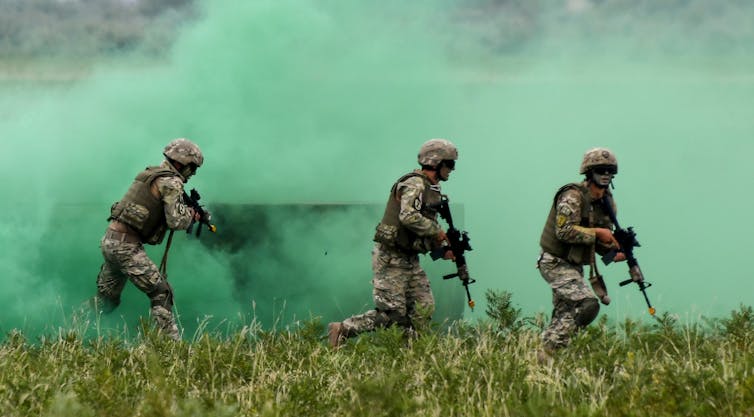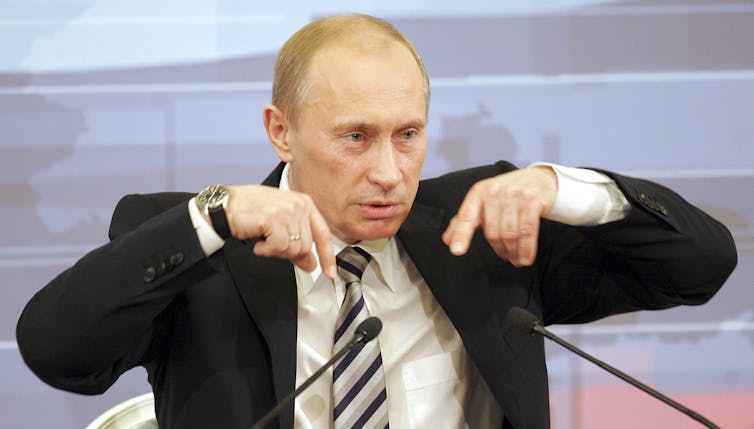.jpg/640px-Destruction_of_Russian_tanks_by_Ukrainian_troops_in_Mariupol_(4).jpg) |
| Choose one: “Destruction of Ukranian w:BMP-3 IFV by Russian troops in Mariupol” or “A destroyed Russian BMP-3 near Mariupol, 7 March 2022”. [A] |
You know the conventional wisdom about the Ukrainian war: it’s all entirely Putin’s fault. That story is easy to understand, isn’t it? Politicians and journos and pundits for hire never cease to drive home the message.
It has its weaknesses though. One of them is that it needs Putin – who on top of having Parkinson’s disease and at least two different flavours of terminal cancer – to be both bad and kooky … never mind that madness precludes responsibility. Depending on who you hear, the bloke is a Machiavellian master manipulator … or an inept tin pot dictator. Incidentally, the same applies to the Russian military, at times described as a serious and imminent threat to the security of Europe, at times lambasted as useless, clumsy, incompetent and corrupted – sometimes by the same people, at the same time.
(Rationality and consistency, you see, are too much to ask from simplistic speculative accounts, mixing in equal parts wishful thinking, virtue signalling and ignorance. To those basic ingredients, they only need to add a pinch of contempt for our intelligence, and personal dishonesty to taste and ta-da! Bon appétit!)
What you may not know, because politicians and journos and pundits for hire relentlessly do their best to hide it, is that there is a better, smarter explanation, advanced not by fringe conspiracy theorists or Putin puppets, but by bona fide academics and practitioners. It’s particularly good, because it shows how we got into this mess. Who would have thought that history actually matters?
It has a drawback though: it’s more complex than the dominant good-and-evil morality tale.
The good news is that a basic understanding can be gained, with little effort, thanks to serious academics:
Ukraine war follows decades of warnings that NATO expansion into Eastern Europe could provoke Russia

As fighting rages across Ukraine, two versions of reality that underlie the conflict stare across a deep divide, neither conceding any truth to the other.
The more widespread and familiar view in the West, particularly in the United States, is that Russia is and has always been an expansionist state, and its current president, Vladimir Putin, is the embodiment of that essential Russian ambition: to build a new Russian empire.
“This was … always about naked aggression, about Putin’s desire for empire by any means necessary,” President Joe Biden said on Feb. 24, 2022.
The opposing view argues that Russia’s security concerns are in fact genuine, and that NATO expansion eastward is seen by Russians as directed against their country. Putin has been clear for many years that if continued, the expansion would likely be met with serious resistance by the Russians, even with military action.
That perspective isn’t held just by Russians; some influential American foreign policy experts have subscribed to it as well.
Among others, Biden’s CIA director, William J. Burns, has been warning about the provocative effect of NATO expansion on Russia since 1995. That’s when Burns, then a political officer in the U.S. Embassy in Moscow, reported to Washington that “hostility to early NATO expansion is almost universally felt across the domestic political spectrum here.”
NATO edging toward Russia
The North Atlantic Treaty Organization, or NATO, is a military alliance that was formed by the U.S., Canada and several European nations in 1949 to contain the USSR and the spread of communism.
Now, the view in the West is that it is no longer an anti-Russian alliance but is instead a kind of collective security agreement aimed at protecting its members from outside aggression and promoting peaceful mediation of conflicts within the alliance.
Recognizing the sovereignty of all states and their right to ally with whatever state they wish, NATO acceded over time to the requests of European democracies to join the alliance. Former members of the Soviet-established Warsaw Pact, which was a Soviet version of NATO, were also brought into NATO in the 1990s, along with three former Soviet republics – Estonia, Latvia and Lithuania – in 2004.
The Western view is that the Kremlin is supposed to understand and accept that the alliance’s activities, among them war games replete with American tanks staged in nearby Baltic states and rockets stationed in Poland and Romania – which the U.S. says are aimed at Iran – in no way present a threat to Russian security.

Many warnings about Russia’s reaction
Russian elite and broad public opinion have both long been opposed to such expansion, the placement of American rockets in Poland and Romania and the arming of Ukraine with Western weaponry.
When President Bill Clinton’s administration moved to bring Poland, Hungary and the Czech Republic into NATO, Burns wrote that the decision was “premature at best, and needlessly provocative at worst.”
He continued, “As Russians stewed in their grievance and sense of disadvantage, a gathering storm of ‘stab in the back’ theories slowly swirled, leaving a mark on Russia’s relations with the West that would linger for decades.”
In June 1997, 50 prominent foreign policy experts signed an open letter to Clinton, saying, “We believe that the current U.S. led effort to expand NATO … is a policy error of historic proportions” that would “unsettle European stability.”
In 2008, Burns, then the American ambassador to Moscow, wrote to Secretary of State Condoleezza Rice: “Ukrainian entry into NATO is the brightest of all redlines for the Russian elite (not just Putin). In more than two and a half years of conversations with key Russian players, from knuckle-draggers in the dark recesses of the Kremlin to Putin’s sharpest liberal critics, I have yet to find anyone who views Ukraine in NATO as anything other than a direct challenge to Russian interests.”

Responding to Russia’s insecurity
There are different outcomes to the current crisis depending on whether you see its cause as Russian imperialism or NATO expansionism.
If you think the war in Ukraine is the work of a determined imperialist, any actions short of defeating the Russians will look like 1938 Munich-style appeasement and Joe Biden becomes the reviled Neville Chamberlain, the British prime minister who acceded to Hitler’s demands for territory in Czechoslovakia only to find himself deceived as the Nazis steadily marched to war.
If, however, you believe that Russia has legitimate concerns about NATO expansion, then the door is open to discussion, negotiation, compromise and concessions.
Having spent decades studying Russian history and politics, I believe that in foreign policy, Putin has usually acted as a realist, unsentimentally and amorally taking stock of the power dynamics among states. He looks for possible allies ready to consider Russia’s interests – recently he found such an ally in China – and is willing to resort to armed force when he believes Russia is threatened.
But at times he has also acted on the basis of his ideological predilections, which include his fabricated histories of Russia. Occasionally, he’s acted impulsively, as in seizing Crimea in 2014, and rashly, as in his disastrous decision to invade Ukraine. Annexing Crimea after Ukraine’s pro-democracy Maidan revolution in 2014 combined both a strategic imperative to hold onto the Black Sea naval base at Sevastopol and a nationalist justification, after the fact, to bring the imagined cradle of Russian Christianity and a historic conquest of the czars back into the fold of the “motherland.”
Putin’s sense of Russia’s insecurity vis-à-vis a much more powerful NATO is genuine, but during the current impasse over Ukraine, his recent statements have become more fevered and even paranoid.
Usually a rationalist, Putin now appears to have lost patience and is driven by his emotions.
Putin knows enough history to recognize that Russia did not expand in the 20th century – losing parts of Poland, Ukraine, Finland and eastern Turkey after the 1917 revolution – except for a brief period before and after World War II when Stalin annexed the Baltic republics and pieces of Finland, and united lands from interwar Poland with Soviet Ukraine.
Putin himself was traumatized by the disintegration of the Soviet Union in 1991, the loss of one-third of its former territory and half of its population. In an instant, the USSR disappeared, and Russia found itself much weaker and more vulnerable to rival great powers.
Many Russians agree with Putin and feel resentment and humiliation, along with anxiety about the future. But overwhelmingly they do not want war, Russian pollsters and political analysts say.
Leaders like Putin who feel cornered and ignored may strike out. He has already threatened “military and political consequences” if the currently neutral Finland and Sweden attempt to join NATO. Paradoxically, NATO has endangered small countries on the border of Russia, as Georgia learned in 2008, that aspire to join the alliance.
One wonders – as did the American diplomat George F. Kennan, the father of the Cold War containment doctrine who warned against NATO expansion in 1998 – whether the advancement of NATO eastward has increased the security of European states or made them more vulnerable.
[Understand key political developments, each week. Subscribe to The Conversation’s politics newsletter.]![]()
Ronald Suny, Professor of History and Political Science, University of Michigan
This article is republished from The Conversation under a Creative Commons license. Read the original article.
Image Credits
[A] Choose one of them:
“Destruction of Ukranian w:BMP-3 IFV by Russian troops in Mariupol” or “A destroyed Russian BMP-3 near Mariupol, 7 March 2022”. Author: mvs.gov.ua. file is licensed under the Creative Commons Attribution 4.0 International license. Source: WikiMedia. Nobody endorses me or the use I make of this file.
Hey, Maggie.
ReplyDeleteThat observation about the contradictory account of the Russian military reminds me of that old Umberto Eco line: "Thus, by a continuous shifting of rhetorical focus, the enemies are at the same time too strong and too weak." Probably a coincidence!
Anyway, glad to see you're still posting. Hope you're doing well.
Hey, Hedlund. Glad to see you are still reading! Sorry that I had not seen your comment earlier.
ReplyDelete